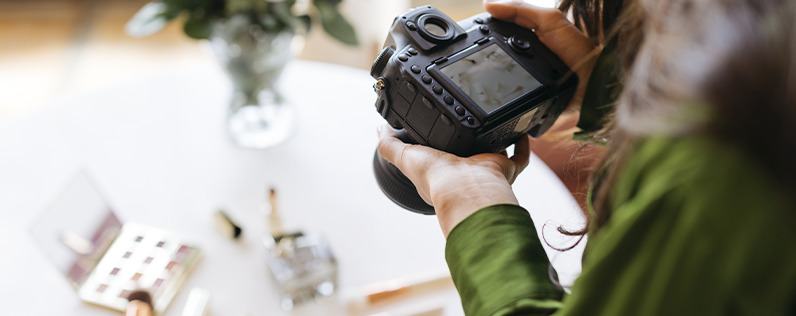
Whether you’re selling makeup through your ecommerce site, showcasing products through your blog, or marketing your services as a makeup artist, quality cosmetic photography can make or break your sales.
When purchasing makeup online, customers don’t have the benefit of trying on the product. Photographing products and models correctly helps your clients visualize the finished look, increasing sales and reducing returns.
We make it easy to get new clients and repeat business with all the marketing tools you need for your nails, hair, skin, or personal care business.
Why cosmetic photography is important for beauty bloggers and retailers
Whether you’re shooting cosmetics for your blog or ecommerce sales, quality cosmetic photography is essential. Shooting products with proper lighting conditions gives clients a realistic impression of product color when shopping online.
By photographing beauty products and swatches correctly, you can make it easier for your customers to choose colors they will like. Thankfully, you don’t have to be an expert photographer to take good pictures of your products and swatches — you just need to know a few tricks.
5 tips for taking a good makeup product photo
1. Use the right light
Since you want your photos to accurately represent each product, natural light is the best for cosmetic photography. If you can, set up your shoot next to a large window in the middle of the day. If you’re shooting products in the evening or in low light conditions, use a reflective screen or a flash diffuser attachment to even out the light.
Natural light will create the right balance of highlights and shadows on your product while keeping it soft and natural. Harsh lights can bounce off reflective surfaces on the packaging, and hard shadows can distort the image.
This post on The Anna Edit blog features some of the blogger’s favorite products. In the mirror, you can see a reflection indicating that this image was most likely shot near a window. All shadows in the image are soft, letting the products stand out.
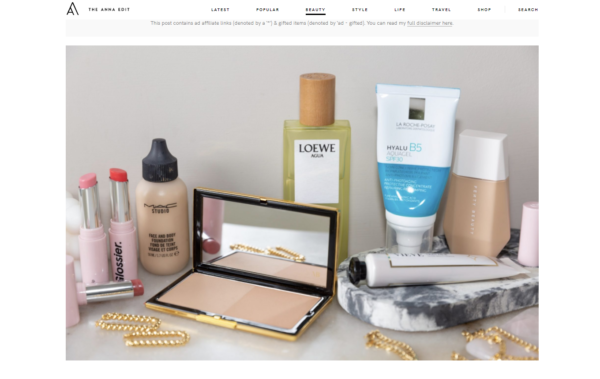
2. Clean your makeup
If you’re a blogger, you’ve probably tested out the makeup serving as the subject for your blog post. If you’re shooting product photos to upload to an ecommerce site, you might choose to liven up the background with product swatches.
After you’re done using the product, clean it. Wipe any excess product off the package. Sharpen pencils and make sure you’re using fresh lipsticks (if you swatch the color, use an old tube to create the swatch and a new one in the photo.
Clean products look fresh and new, which will make them more appealing to potential customers.
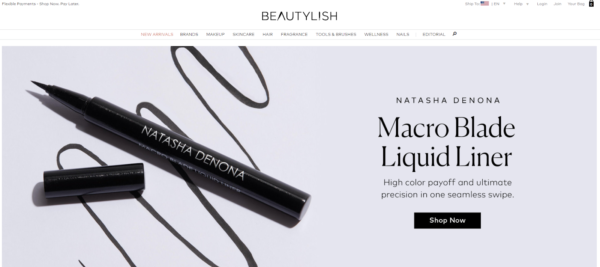
Beautylish, an online beauty retailer based in San Francisco, posted the image above on its website landing page. It features a liquid liner that has been swatched on a piece of paper to showcase the product. Even though the product has been opened and used to create the image, the eyeliner pen itself is clean and free of fingerprints and makeup.
3. Play with your composition
When you’re shooting a line of cosmetics for ecommerce, it’s generally best to use a white background. Most cosmetic photography for ecommerce features the product on its own against a white background. Shooting your products on a white background lets you easily edit out the background if you need to. Most importantly, a white background lets the colors of your product pop without competing with other elements of your image.
However, using an interesting composition with background objects or bold colors in your product images can help them stand out when you want them to. An interesting background can amplify your social media posts and accentuate products displayed on your landing page. If you’re featuring a new product or want to draw attention to one that isn’t selling, consider creating a more engaging layout.
Morphe displayed its new 35D Desert Bouquet Artistry Palette using a simple dark background with dark purple foam pieces sculpted to resemble the desert. The composition is simple, yet the striking, rich colors complement those in the palette and draw their eye toward the colors themselves.
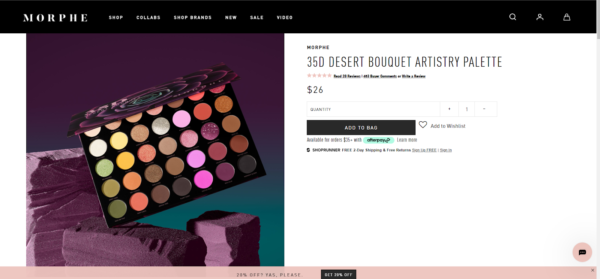
Use background objects and colors that accentuate your products, but keep it simple. A busy composition with an abundance of background objects might draw the eye away from your product. You want to keep the focus on the product, not the other objects in the photo.
4. Display your labels and colors
Cosmetic photography on an ecommerce site is similar to visual merchandising in stores, and the same principles apply. When you’re walking through a makeup store, all products will be displayed on the shelf with the labels out.
Tester products are usually displayed with the lid open or removed so customers can see the colors. On your website, product photos should be shot similarly to how they would be displayed on a shelf. Make sure labels are clearly visible.
When it comes to palettes and other products, it’s best to photograph them with the lid open and the product out, so customers can see what’s inside.
Muse Beauty displays front-facing products on its website. Some of the lip colors are closed, but you can still see the color through the packaging. Others are swatched, so the customer can see the color and product consistency.
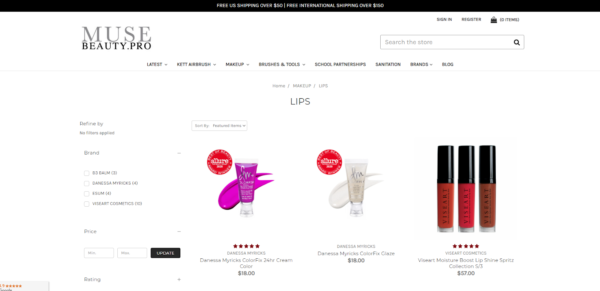
5. Be consistent
Beauty product photography lets you be creative with your styling. You can play with filters and different exposure settings on your camera until you find the combination that suits your style. But once you’ve found a style that works, it’s important to keep it consistent.
The Buff, a customizable skincare and makeup brand, sticks with a minimalist composition for its products. Each product is shot in front of its packaging or another box, and they are set against a pastel background that contrasts with the product’s color.
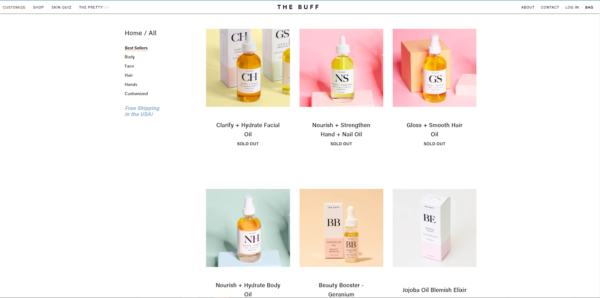
Your cosmetic photography will become a key part of your brand over time. Being consistent with your compositions will help you establish a clear aesthetic and build brand recognition.
Once you’ve used these tips to design your composition, it’s time to set up your shot.
How to set up a product shot
Start by considering the lighting. If you’re in a location with natural light, set up your shoot near the window. Shoot at a time when the light is not streaming directly through the window, but rather serving as a soft, natural light source.
If you’re shooting with a white background, you can use a white sheet, white foam core, or a product backdrop. You can purchase an inexpensive photo studio box to make sure you have the right balance of light and shadow.
Next, arrange your background objects and place the product front and center within the shoot. Instead of shooting your product head-on, shoot from a slightly higher angle. Doing so will make your product appear as though you shot it head-on, but the shadows will be softer, and any hidden styling elements (such as adhesives used to secure products to the set) won’t be visible in the final photo. Take multiple shots so you have several from which to choose.
For creative compositions, shoot from multiple angles. When you’re looking through images later, you might find a standout that you wouldn’t have captured if you stuck with one vantage point. Once you’ve finished shooting the product, make swatches.
How to take an accurate makeup swatch photo
Including makeup swatch photos on your website gives customers an idea of what the product will look like on them. It’s important to take accurate swatch photos so clients will know what to expect when their order arrives. If they receive a product that doesn’t look anything like the swatch, they will probably return it.
1. Use multiple models
Be sure to use multiple models with a variety of different skin tones. This will help customers of all ethnicities get a better understanding of how your product will look on their skin. You can swatch multiple products on each model. Swipe different colors in a line down each model’s arm, making note of each so you can label them in post-production.
2. Determine if you need a primer
Take a variety of test shots with and without makeup primer. Load the photos on your computer and determine which most closely match the color. If you decide to use a primer, use a colorless one or a formula that matches each model’s skin tone so you don’t dilute the makeup color.
3. Choose your light
As with product photos, it’s best to take swatches in natural light. If you need to take your swatch photos in lower light conditions, pay attention to your lighting source. Many interior lights give off a yellow hue which can distort the color of your swatches.
Find a ring light or another lighting source developed specifically for indoor photography, and avoid lighting your swatches directly. Instead, set the light up to bounce off a screen or use a flash diffuser which you can attach to your flash to redistribute the light.
4. Clean your swatch surface
The most common place to swatch makeup is on the forearm, as it’s easy to photograph and generally has a skin tone close to that of the face. Prep your models by washing and exfoliating their forearms. Use a sugar scrub or similar product to make sure no dust or dirt will distort the colors.
5. Make your swatches
Make even swatches that are the same size and keep them straight. The easiest way to create similar swatches is to use a stencil or other straight edge to guide you. If you need to, use makeup remover to clean up the edges.
6. Take the photos
With everything prepped, have your model place their forearm in the light and against the backdrop. Shoot each model from a variety of angles and take multiple photos so you have many from which to choose. You can also photograph all of your models side-by-side so customers can match the products to their own skin tone.
Tips for good lighting for beginners
Lighting is the most important component of good photography. Incorrect lighting can cause your images to look washed out or overly dark. It can distort the colors in your image. Cosmetic photography is all about showcasing the specific colors of each product, so you want your colors to be as accurate as possible.
As always, the most effective lighting source is natural light. Shooting in direct sunlight at high noon will distort your image, creating harsh shadows and potentially odd contours within your image. For product photography, the best light conditions are achieved outside on an overcast day.
The best way to learn how to light your photos is to practice. If you have a professional camera, take it out at different times of day and take a variety of pictures to see how objects appear in different lights. You can also shoot product photos with the camera on your phone. If you’re using your phone, practice shooting different household objects under different lighting conditions.
1. Train yourself to evaluate tone
Different lights have different undertones, which impact the look of cosmetic photography. Your living room lamp likely gives off a warm tone, which can make photos look more yellow than they would under natural light. A fluorescent light or other commercial lighting source might emit a cooler tone.
Start taking photos of white walls or a piece of paper under different lights. Load the photos into your computer and open them with a photo editing program. You should be able to tell if the lighting is cool or warm based on how it looks in a program like Photoshop.
2. Focus on your most dominant light source
When you’re staging your photoshoot, it’s important to control your primary lighting source. For example, if you’re shooting outside, your main light source is the sun. You can control how your subjects look by using reflective screens or diffusers to point sunlight toward your subject and soften the shadows.
3. Bring your own light source
With the rise of social media and video conferencing, lighting sources are increasingly accessible to beginners. Start by picking up a ring light and a diffuser attachment for your flash. Set up the light at an angle instead of situating it directly in front of your subject. Placing your light on the side will keep it from creating harsh shadows.
4. Back up
When you’re starting out, you might have a tendency to place your light source too close to your subject. If you’re photographing a person, this can result in glare or red eye. In cosmetic photography, lighting from the wrong angle can distort highlighting and contouring.
In cosmetic photography, placing a light source too close can create reflections. If you’re shooting a glass product like a perfume or foundation bottle, the light can bounce off the product, creating spots in your photo. Moving your light source farther away will help alleviate any glare.
You might not notice lighting issues right away. They’re usually more apparent when you’ve loaded your pictures onto your computer and can look at them on a bigger screen.
If you have a digital camera, you can counteract the light by adjusting the settings on your camera. You might be tempted to use your automatic settings, but learning how to get the most out of your camera will save editing time and improve your end result.
Three essential camera settings for beginners
All photographs are created with light. In film photography, cameras use a shutter and a small mirror to direct light into the camera, which exposes the film. The objects in the mirror cause the film to expose at different levels, which in turn creates the image that you see on the final print.
Digital cameras work with the same principle, in that you are controlling the amount of light that enters your camera to record an image. There are three settings that will help you manipulate how much light enters the camera.
1. Aperture
Your aperture is the diaphragm that is attached to your lens. When you set the F stop on your camera, it tells this diaphragm how much or how little to open. If the number is larger, then the aperture is smaller, meaning less light is entering your camera.
In low-light situations, you want to use a smaller aperture number to let more light into your camera. Using your F stop settings makes it easier to create blurry backgrounds, letting a viewer focus on your subject.
Product photography often makes use of low or medium aperture, because it generally creates better depth of field. Practice taking pictures of the same object with a different F stop setting to see how it impacts the final image.
One drawback to using a larger F stop is that these settings require slower shutter speeds, which runs the risk of blurring your image, especially if you shake or move when taking the photo. To avoid this issue, use a tripod on product shoots.
2. Shutter speed
Your digital camera also lets you adjust the shutter speed. This setting refers to how long the shutter remains open, exposing the camera’s interior to light.
When taking photos in natural light and outside, faster shutter speeds will produce the best results. If you’re using a longer shutter speed in an outdoor setting, you risk overexposing the photo. You can tell a photo is overexposed if it looks too bright when you load it into your computer.
Photography Life’s blog post provides a useful overview of exposure. In the example below, you can see that the photo is overexposed because of its brightness and the overall lack of contrast.

On your digital camera, you can set the shutter speed when you have your camera set to manual. Your shutter speed will be displayed as a fraction, such as 1/1000 or 1/225. This refers to fractions of a second. A larger number on the bottom indicates a faster shutter speed.
Eliminate camera shake by shooting your makeup products at a shutter speed of 1/125 or higher and use good lighting to make sure the image comes out looking sharp and in focus.
ISO
Your ISO setting refers to your camera’s ability to capture light. If you’ve taken a film photography class or have ever shot with a 35mm film camera, the ISO is the equivalent of film speed. When you start shooting with a higher ISO, your photos end up looking grainy.
You should be able to brighten or darken your photos using your F stop and shutter speed settings. You don’t really need to worry about your ISO settings unless you’re shooting in a darker environment. The ISO setting for product photography will be lower if you’ve adjusted your other settings and have set up your lighting.
Putting it into practice
Knowing the basics of product photography can elevate your website. You’ll be able to shoot your own basic inventory photos to load onto your shopping page. In this section of your site, you want your images to be clean and simple.
Start with new, clean products and shoot them against a white background in natural light or with a light source that is placed at an angle instead of head-on. If you need to diffuse the light, consider a reflective screen or an attachment to place over your flash.
For blog posts and social media, get creative with your composition. Use colors and background elements that communicate your brand personality but don’t detract from the product itself. Be sure to use multiple models and shoot them under natural light or studio lighting to create accurate swatches.
You’ll need to get familiar with your camera’s settings. Practice photographing items in your home or go out and take pictures in your neighborhood. Use different shutter speeds and F stop settings to learn how each of them affects the end result.
Once you’re comfortable with your camera and its settings, you’ll be ready to create your brand’s unique aesthetic.




